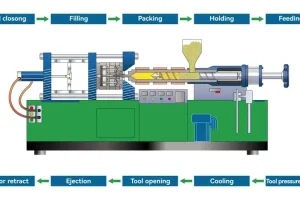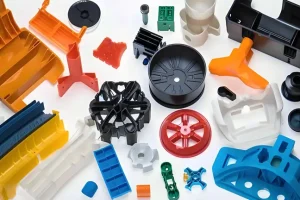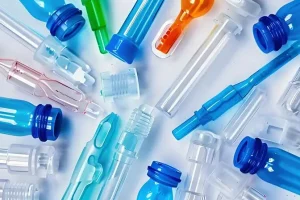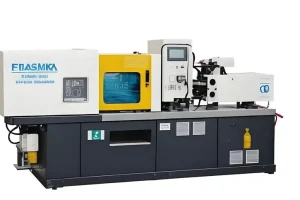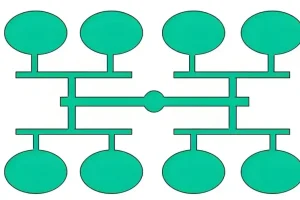Introduction: Injection molding is a common manufacturing process that injects plastic material into a mold, then deforms the material and finally forms it by heating and cooling. However, during the injection molding process, warping sometimes occurs, which affects the quality and production efficiency of the product. There are many reasons for warping deformation, and it is often difficult to solve it by relying solely on process parameters.

Combining relevant information and actual work experience, the following is an analysis of the causes and solutions for warping in plastic injection molding warpage.
What is Warping?
It means that the shape of the injection molded product is different from the shape of the mold cavity, which is one of the common defects of plastic products.

Causes of Warpage in Injection Molding
There are many reasons for warping in injection molding, some of which are common reasons:
Structure of the Mold
In terms of molds, the factors that affect the deformation of plastic parts mainly include the pouring system, cooling system and ejection system.

Gating System
The position, form, and number of the injection mold gate will affect how the plastic fills the mold cavity, which can cause the plastic part to warp.

The longer the flow distance, the greater the internal stress caused by the flow and shrinkage compensation between the frozen layer and the central flow layer.
Conversely, the shorter the flow distance, the shorter the flow time from the gate to the end of the flow of the part, the thinner the thickness of the frozen layer during mold filling, the lower the internal stress, and the warping deformation will be greatly reduced.

For some flat plastic parts, if only one central gate is used, the plastic parts will be distorted after molding because the shrinkage rate in the diameter direction is greater than the shrinkage rate in the circumferential direction. If multiple point gates or film gates are used instead, warping deformation can be effectively prevented.
When using edge gates for molding, the location and quantity of gates also have a big effect on how much the plastic part warps because plastic shrinkage isn’t the same in all directions.

Also, using multiple gates can make the plastic flow ratio (L/t) shorter, which makes the melt density in the mold cavity more even and the shrinkage varies more even. At the same time, the whole plastic part can be filled at a lower injection pressure. And a lower injection pressure can reduce the plastic’s tendency to have molecular or fiber alignment orientation and reduce its internal stress, which reduces the plastic part’s deformation.
Cooling System
When you inject plastic, the part cools unevenly. This makes the part shrink unevenly. The uneven shrinkage makes the part bend. The bending makes the part warp.

If the temperature difference between the mold cavity and the core used in the injection molding of flat plastic parts (such as mobile phone battery shells) is too large, the melt close to the cold mold cavity surface will cool down quickly, while the material layer close to the hot mold cavity surface will continue to shrink. The uneven shrinkage will cause the plastic warpage.
Therefore, the cooling of the injection mold should pay attention to the temperature of the cavity and the core tending to balance, and the temperature difference between the two should not be too large (at this time, two mold temperature controllers can be considered).

When you’re thinking about the temperature balance of the inside and outside of the plastic part, you also need to think about the temperature balance of each side of the plastic part. That is, when the mold is cooling, you want to try to keep the temperature of the cavity and the core as even as possible. This way, each part of the plastic part cools at the same speed, so each part shrinks at the same rate, and you don’t get any warping.
So, you want to make sure that the temperature of the cavity and the core are the same.The arrangement of cooling water holes on the mold is very important. After the distance from the tube wall to the cavity surface is determined, the distance between the cooling water holes should be kept as small as possible to ensure the uniform temperature of the cavity wall.

Also, because the temperature of the cooling medium increases as the length of the cooling water channel increases, there will be a temperature difference between the mold cavity and the core along the water channel. Therefore, the length of each cooling circuit water channel should be less than 2 meters.
For large molds, multiple cooling circuits should be set, and the inlet of one circuit should be near the outlet of another circuit. For long plastic parts, straight-through water channels should be used. (And most of our molds use S-shaped circuits-not conducive to circulation, but also prolong the cycle.).

Ejector System
The design of the ejector system also directly affects the deformation of plastic parts. If the ejector system is unbalanced, it will cause an imbalance in the ejection force and cause the plastic part to deform.
Therefore, when designing the ejector system, it should strive to balance with the demolding resistance. In addition, the cross-sectional area of the ejector rod should not be too small to prevent the plastic part from being deformed due to excessive force per unit area (especially when the demolding temperature is too high).

The ejector rod should be placed as close as possible to the part with the most resistance to being removed from the mold. Without affecting the quality of the plastic parts (including their use, dimensional accuracy, appearance, etc.), as many ejector pins as possible should be used to reduce the overall deformation of the plastic parts (this is why ejector pins are replaced with ejector blocks).
When using soft plastics (like TPU) to make deep-cavity thin-walled plastic parts, because of the large demoulding resistance and the soft material, if you use only one mechanical ejection method, the plastic parts will be deformed, even penetrated or folded, and the plastic parts will be scrapped. If you use a combination of multiple components or gas (liquid) pressure and mechanical ejection, the effect will be better (will be used later).

Plasticization Stage
The plasticizing stage is when the glassy particles turn into a gooey melt (we talked about the three states of plasticizing raw materials in training). During this stage, the temperature difference of the polymer in the axial and radial directions (relative to the screw) will stress the plastic; also, the injection pressure, speed, and other parameters of the injection machine will greatly affect how the molecules line up when the mold fills, which will cause warping.
Filling and Cooling Stage
The melted plastic is injected into the mold under injection pressure and cooled and solidified in the mold. This process is the key step of injection molding. In this process, temperature, pressure, and speed are interrelated and have a great impact on the quality and production efficiency of plastic parts.

Higher pressure and flow rate will produce high shear rate, which will cause differences in molecular orientation parallel to the flow direction and perpendicular to the flow direction, and produce a “freezing effect”. The “freezing effect” will produce freezing stress and form internal stress of plastic parts.
Temperature affects warpage in the following ways:
Temperature differences between the top and bottom surfaces of the plastic part cause thermal stress and deformation. Temperature differences between different areas of the plastic part cause uneven shrinkage. Different temperature conditions affect the filler or fiber reinforcement.

Shrinkage of Injection Molded Products
The main reason why injection molded products warp is because the shrinkage of the plastic parts is uneven. If the shrinkage effect during the filling process is not considered during the mold design stage, the actual shape of the product will be very different from the design requirements, and severe deformation will cause the product to be scrapped (that is, the problem of shrinkage rate).
Besides deformation from filling, the temperature difference between the top and bottom walls of the mold will also cause differences in shrinkage between the top and bottom surfaces of the plastic part, resulting in warpage. For warpage analysis, shrinkage itself is not important, but the difference creates internal stresses in shrinkage is important.

When you make plastic parts with injection molding, the plastic molecules line up in the direction the plastic flows. This makes the plastic shrink more in the direction the plastic flows than it does in the direction that’s up and down. This makes the plastic parts warp (which is called anisotropy).
Normally, uniform shrinkage only causes changes in the volume of plastic parts, and only uneven shrinkage can cause warping. The difference between the shrinkage rates of crystalline materials in the flow direction and the vertical direction is greater than that of non-crystalline plastics, and their shrinkage rate is also greater than that of non-crystalline plastics.

The large shrinkage of crystalline plastics and their anisotropy of shrinkage are superimposed, resulting in a tendency to affect the warping of crystalline plastic parts that is much greater than that of non-crystalline plastics.
Residual Thermal Stress
When you make stuff with injection molding, the heat from the process can make the stuff warp. That’s bad because it makes the stuff not good. The heat can make the stuff warp in different ways, but I’m not going to talk about that now.

Improvement Measures for Warpage of Injection Molded Parts
Influence of Mold Design
When it comes to mold design, the things that affect how plastic parts get all deformed are mostly the pouring system, cooling system, and ejection system, and so on.
Gating System
a) The position, form, and number of the injection mold gate will affect how the plastic fills the mold cavity, which can cause the plastic part to warp. The longer the distance the plastic has to flow, the more stress it creates inside the part as it flows and shrinks between the frozen layer and the center flow layer.

On the other hand, the shorter the distance the plastic has to flow from the gate to the end of the part, the thinner the frozen layer is during mold filling, the less stress there is inside the part, and the less it will warp.
b) For some flat plastic parts, if you only use one central gate, the shrinkage rate in the diameter direction is greater than the shrinkage rate in the circumferential direction, and the plastic parts will be distorted after molding. If you use multiple point gates or film gates instead, you can effectively prevent warpage.

c) For long, strip-shaped plastic parts, the gate is placed at the end, and the molten material flows along the length direction, which can reduce the deformation caused by the gate design in the middle.
d) When using point gates for molding, due to the anisotropy of plastic shrinkage, the location and number of gates have a great influence on the degree of deformation of the plastic part. In addition, the use of multiple gates can also reduce the flow ratio (L/t) of the plastic, so that the melt density in the mold cavity is more uniform and the shrinkage is more uniform.

e) For ring-shaped products, the roundness of the final product is also affected by different gate shapes, and it can be filled under a smaller injection pressure. The smaller injection cavity pressure can reduce the molecular orientation tendency of the plastic, reduce its internal stress, and thus reduce the deformation of the plastic part.
Cooling System
a) If the injection molded part melting and cooling characteristics unevenly, the plastic part will shrink unevenly. This difference in shrinkage creates a bending moment and causes the plastic part to warp.

If the temperature difference between the mold cavity and the core used to injection mold flat plastic parts (like mobile phone battery shells) is too large, the melt near the cold mold cavity surface will cool quickly, while the material near the hot mold cavity surface will continue to shrink.
This uneven shrinkage will cause the plastic part to warp. Therefore, when cooling the injection mold, pay attention to the temperature of the cavity and the core to balance out, and the temperature difference between the two should not be too large (at this time, you can consider using two mold temperature controllers).

b) The temperature on both sides of the injection molded part should be the same. When the mold cools, the temperature of the cavity and the core should be kept the same as much as possible. This way, the plastic part cools at the same speed everywhere, so it shrinks evenly and doesn’t warp.
c) The arrangement of cooling water holes on the mold is crucial. This includes the cooling water hole diameter, the water hole spacing b, the distance from the tube wall to the cavity surface, and the product wall thickness.

Once the distance from the tube wall to the cavity surface is determined, the distance between the cooling water holes should be kept as small as possible to ensure the uniform temperature of the cavity wall.
d) Things to consider when deciding the diameter of the cooling water hole. No matter how big the mold is, the diameter of the water hole can’t be more than 14mm, otherwise it’s hard for the coolant to make turbulent flow. Generally, the diameter of the water hole can be decided according to the average wall thickness of the product.

When the average wall thickness is 2mm, the diameter of the water hole is 8-10mm; when the average wall thickness is 2-4mm, the diameter of the water hole is 10-12mm; when the average wall thickness is 4-6mm, the diameter of the water hole is 10-14mm.
e) Because the temperature of the cooling medium increases as the length of the cooling water channel increases, there will be a temperature difference between the cavity and core of the mold along the water channel. Therefore, the length of each cooling circuit water channel should be less than 2 meters.

f) For square plastic parts, the cooling effect is enhanced by embedding copper at the four corners of the mold. The four corners are where heat accumulates, so this improves the deformation of the parts.
9) You should put a bunch of cooling circuits in big molds, and you should put the inlet of one circuit near the outlet of another circuit. For long plastic parts, you should use straight-through water channels.
Ejector System
a) The design of the ejector system also directly affects the deformation of plastic parts. If the ejector system is unbalanced, the ejector force will be unbalanced and the warped injection molded plastic will be deformed. Therefore, when designing the ejector system, it should be balanced with the demolding positive force.

b) Optimize the demolding effect (set the ejector pin at the rib/bone position) to improve the changes caused by poor demolding of plastic parts.
c) The cross-sectional area of the ejector rod should not be too small to prevent the plastic parts from being deformed due to excessive force per unit area (especially when the demolding temperature is high).
d) Arrange the ejector rod as close as possible to the part with the highest resistance to being removed from the mold.

e) Set as many ejector rods as possible without affecting the quality of the plastic parts (including use requirements, dimensional accuracy, appearance, etc.) to reduce the overall deformation of the plastic parts. If necessary, replace the ejector rods with ejector blocks.
f) When you’re using soft plastics (like TPU) to make plastic parts with deep cavity walls, because of the big resistance to demolding and the soft fiber reinforced materials fibers, if you use just one mechanical ejection method, the plastic parts will get deformed, even go through or fold, and you’ll have to throw them away. If you use a combination of multiple components or air (liquid) pressure and mechanical ejection, it’ll work better.

9) For deep cavity molds, we add air intake devices to the front and back molds to make the vacuum suction deformation better.
Plasticization Stage
Multi-stage injection control can reasonably set multi-stage injection pressure, injection speed, holding pressure, and sol method according to the structure of the runner, the form of the gate, and the structure of the injection molded part. This is good for preventing warping deformation.

Mold Cooling
The plastic cools at different speeds, which makes it shrink unevenly. This uneven shrinkage creates a bending force that warps the plastic part.
For instance, when you’re injection molding flat plastic parts, if the temperature difference between the mold cavity and the core is too big, the plastic will cool down quickly near the cold mold cavity surface, but the material near the hot mold cavity surface will keep shrinking.

This uneven shrinkage will cause the plastic part to warp. So, when you’re cooling the injection mold, you need to make sure the temperature of the cavity and the core is balanced, and the temperature difference between the two is not too big.
The arrangement of the cooling water holes on the mold is also very important. After the distance from the tube wall to the cavity surface is determined, the distance between the cooling water holes should be as small as possible to ensure that the temperature of the cavity wall is uniform.

At the same time, since the temperature of the cooling medium increases with the increase of the length of the cooling water channel, the mold cavity and core will have a temperature difference along the water channel.
Therefore, the water channel length of each cooling circuit is required to be less than 2m. Several cooling circuits should be set in large molds, and the inlet of one circuit is located near the outlet of another circuit.

For long plastic parts, a cooling circuit should be used to reduce the length of the cooling circuit, that is, to reduce the temperature difference of the mold, so as to ensure uniform cooling of the plastic parts.
Product Shrinkage
Normally, uniform shrinkage only affects the volume of the plastic, and only uneven shrinkage causes warping. The difference in shrinkage difference occurs between the flow direction and the vertical direction of crystalline plastics is greater than that of non-crystalline plastics.

For the multi-stage injection process selected based on the analysis of the geometric shape of the product, due to the thin wall and long flow length ratio of the product, the melt must flow through quickly,
otherwise it is easy to cool and solidify, and high-speed injection should be set for this. However, high-speed injection will bring a lot of kinetic energy to the melt, and when the melt flows to the bottom, it will produce a lot of inertial impact, resulting in energy loss and overflow. At this time, the melt must slow down the flow rate, reduce the filling pressure.

And maintain the so-called holding pressure so that the melt can supplement the shrinkage of the melt in the mold cavity before the gate solidifies. This puts forward requirements for multi-stage injection speed and pressure in the injection molding process.
Residual Thermal Stress
When the plastic is being molded, it doesn’t cool evenly, so it shrinks unevenly. That means it has uneven stress inside. So when you take it out of the mold, it warps because of the uneven stress.

The phase transformation and stress relaxation behavior of plastic from liquid to solid during the cooling stage. For the uncured area, the plastic acts like a viscous fluid, which is described by the viscous fluid model. For the cured area, the plastic acts like a viscoelastic material, which is described by the standard linear solid model.
Therefore, mold makers or product developers can use the viscoelastic phase transformation model and the two-dimensional finite element method to predict thermal residual stress and corresponding warpage.

Conclusion
polypropylene tensile bar shrinkage without glass fiber at two gate locations .There are many things that can make your plastic parts warp.The design of the mold, the type of plastic materials shrink you’re using, and how you run the molding machine all have different amounts of influence on how much your parts warp. So, if you want to fix your warped parts, you have to think about all of these things.


